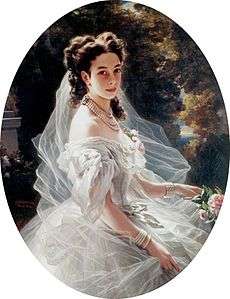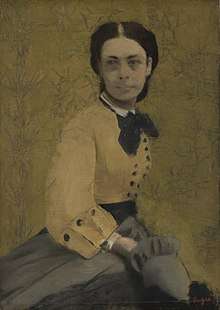Pauline von Metternich
Pauline Clémentine Marie Walburga, Princess of Metternich-Winneburg zu Beilstein (née Countess Pauline Sándor de Szlavnicza; 25 February 1836 – 28 September 1921) was a famous Austrian socialite, mainly active in Vienna and Paris. Known for her great charm and elegance as well as for her social commitment, she was an important promoter of the work of the German composer Richard Wagner and the Czech composer Bedřich Smetana. She was also instrumental to the creation of the haute couture industry.[1]
Pauline | |
|---|---|
| Princess of Metternich-Winneburg zu Beilstein | |
 Portrait by Franz Xaver Winterhalter, 1860 | |
| Full name
Pauline Clémentine Marie Walburga | |
| Born | 25 February 1836 Vienna, Austrian Empire |
| Died | 28 September 1921 (aged 85) Vienna, Republic of Austria |
| Spouse(s) | Richard, 2nd Prince of Metternich-Winneburg zu Beilstein |
| Issue
Princess Sophie von Metternich-Sandor Winneburg Princess Pascalina Antoinette von Metternich-Sandor Winneburg Princess Klementina Marie von Metternich-Sandor Winneburg | |
| Father | Count Moritz Sándor |
| Mother | Leontine von Metternich |
Life
.jpg)
Pauline was born in Vienna into the Hungarian noble family of Sándor de Szlavnicza. Her father, Count Móric Sándor (1805–1878), described as "a furious rider", was known throughout the Habsburg empire as a passionate horseman. Her mother, Princess Leontine von Metternich-Winneburg (1811–1861), was a daughter of the Austrian state chancellor Prince Klemens Wenzel von Metternich (known as the architect of the Concert of Europe). It was at his home in Vienna that Pauline spent almost her whole childhood.
In 1856, she married her uncle, Prince Richard von Metternich (1829–1895), whereby her grandfather Prince Klemens Wenzel von Metternich also became her father-in-law.[2] The couple lived a happy conjugal life, despite Richard's frequent love-affairs with actresses and opera prima donnas. Their first child was Sophie (born 1857); her second daughter, Pascaline (b. 1862), married Count Georg von Waldstein-Wartenberg, an insane and alcoholic Czech aristocrat who was said to have murdered her in delirium in Duchcov (today in the Czech Republic) in 1890. Her youngest daughter, Clementine (b. 1870), was badly injured by her dog as a child and decided never to marry due to her scarred face.
Socialite

Pauline accompanied her husband, an Austrian diplomat, on his missions to the royal Saxon court in Dresden and in 1859 to the imperial French court in Paris, where they lived for more than eleven years until the Franco-Prussian war of 1870/71. She played an important role in the social and cultural life of both Dresden and Paris, and, after 1871, Vienna. Pauline's regular travels between, and extended stays in, Paris and Vienna, permitted her to act as a cross-cultural transmitter of the many trends that interested her in music, political ideas, and sport. She was a close friend and confidante of French Empress Eugénie, and, with her husband, was a prominent personality at the court of Emperor Napoleon III. In 1860 she introduced fashion designer Charles Frederick Worth to the Empress and thus started his rise to fame.
Princess Pauline was an ardent patron of music and contemporary arts, and also became a leader of fashionable society. Whether in Paris or Vienna, she set the latest social trends. She taught French and Czech aristocrats to skate, and ladies to smoke cigars without fear of their reputations. She was acquainted with many composers and writers, including Charles Gounod, Camille Saint-Saëns, Prosper Mérimée and Alexandre Dumas), and corresponded with them. She befriended music composers Richard Wagner (who dedicated a piano composition to her) and Franz Liszt, and backed their career. At her request, Emperor Napoleon III invited Wagner to substantially amend his Tannhäuser for a special 1861 performance by the Paris Opéra, a revision that forms the basis of what is today known as the "Paris version". The project failed (it closed after three performances) and became a celebrated fiasco and one of the greatest music-related scandals of the nineteenth century. Nevertheless, Pauline continued to spread the music of Wagner and other now-famous composers. Wagner later called her his most substantial support beside the Berlin socialite Marie von Schleinitz. One of her protégés was the leading Czech musician of that time, Bedřich Smetana, whom she introduced to the music circles of Vienna and Paris. Thanks to Pauline, Smetana's comic opera The Bartered Bride was produced in Vienna in 1892, to popular acclaim. She also organised salon performances of abridged versions of many famous operas, including Richard Wagner's Der Ring des Nibelungen, in which she took part both as a stage director and singer. The composer Karl Michael Ziehrer dedicated her one of his dances.
In her private life, however, Pauline suffered several crises and disasters. As a child, she was an eyewitness to the bloody Revolution of 1848 in Vienna. In 1870 she remained at the side of Empress Eugénie in Paris during the Franco-Prussian War. Later she aided the Empress' escape from Paris to Great Britain by secretly sending Eugénie's jewels to London in a diplomatic bag. In Vienna, she was admired for her social engagement, but also feared for her gossiping. Her enmity with Empress Elisabeth of Austria was almost legendary and was enjoyed by the Habsburg court. After Elisabeth's death in 1898, Pauline together with Princess Eleonora Fugger von Babenhausen took the leading role of grand dames of the Vienna society.
Duel

It is claimed that in August 1892, Pauline took part in a duel with Countess Anastasia von Kielmannsegg. However there are no primary sources for the story, only accounts from foreign newspapers[3]; furthermore, a denial by the Princess was printed in a French newspaper not long after the first accounts were published in which she calls the story a "ridiculous invention by Italian journalists."[4]
Legacy
Princess Pauline died in Vienna in 1921. She lived through the glory and fall of the Austrian and French empires and was believed to be a living symbol of these two lost worlds. A portrait of her by French impressionist Edgar Degas, painted from a photograph, now hangs in the National Gallery, London.
She wrote two books of memoirs. The first, Gesehenes, geschehenes, erlebtes, in German, honored her grandfather, Chancellor Metternich, and father, Count Moritz Sándor, and the second, Éclairs du passé, in French, recalled her life and times in the court of Emperor Napoleon III and Empress Eugénie. Both were published posthumously in the 1920s.
Issue
Richard and Pauline von Metternich had three children :
- Princess Sophie von Metternich-Sandor Winneburg (1857–1941)
- Princess Pascalina Antoinette von Metternich-Sandor Winneburg (1862–1890)
- Princess Klementina Marie von Metternich-Sandor Winneburg (1870-1963)
Since the marriage produced no sons, Richard's title of "Prince von Metternich" passed to his half-brother, Paul von Metternich.
Memoirs
- Pauline Clementine Marie Walburga (Sándor von Szlavnicza), Fürstin von Metternich-Winneburg. The Days That Are No More: Some Reminiscences. E. Nash & Grayson, London (1921). ASIN B000881512
- Pauline Clementine Marie Walburga (Sándor von Szlavnicza), Fürstin von Metternich-Winneburg. My Years in Paris. E. Nash & Grayson, London (1922). ASIN B00085ZS7W
Literature
- Octave Aubry, L'Impératrice Eugénie, Paris 1937.
- Jules Gesztesi, Pauline Metternich. Ambassadrice aux Tuileries, Paris 1947.
- Theophila Wassilko, Fürstin Pauline Metternich, Munich 1959.
- Brigitte Hamann, Elisabeth. Kaiserin wider Willen, Vienna 1982.
External links
| Wikimedia Commons has media related to Princess Pauline de Metternich. |
- Sándor family (Hungarian: hu:Sándor család
References
- http://www.fashionintime.org/history-haute-couture-first-couturier/
- Paulina Sandor at thePeerage.com http://www.thepeerage.com/p44523.htm#i445229
- http://jenniwiltz.com/the-dueling-princess-pauline-metternich/
- "Nouvelles et Echos". Gil Blas. 1892-08-26. Retrieved 2019-12-11.
Canard stupide et ridicule inventé par journaux italiens.